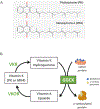New insights into vitamin K biology with relevance to cancer
- PMID: 36028390
- PMCID: PMC9509427
- DOI: 10.1016/j.molmed.2022.07.002
New insights into vitamin K biology with relevance to cancer
Abstract
Phylloquinone (vitamin K1) and menaquinones (vitamin K2 family) are essential for post-translational γ-carboxylation of a small number of proteins, including clotting factors. These modified proteins have now been implicated in diverse physiological and pathological processes including cancer. Vitamin K intake has been inversely associated with cancer incidence and mortality in observational studies. Newly discovered functions of vitamin K in cancer cells include activation of the steroid and xenobiotic receptor (SXR) and regulation of oxidative stress, apoptosis, and autophagy. We provide an update of vitamin K biology, non-canonical mechanisms of vitamin K actions, the potential functions of vitamin K-dependent proteins in cancer, and observational trials on vitamin K intake and cancer.
Keywords: Gla proteins; cancer; menaquinone; phylloquinone; vitamin K.
Copyright © 2022 Elsevier Ltd. All rights reserved.
Conflict of interest statement
Declaration of interests The authors declare no conflicts of interest.
Figures



References
-
- Shearer MJ and Okano T (2018) Key Pathways and Regulators of Vitamin K Function and Intermediary Metabolism. Annu Rev Nutr 38, 127–151. - PubMed
RESOURCES
-
- ECKO trial registered with National Clinical Trials network (# NCT00150969) https://clinicaltrials.gov/ct2/show/NCT00150969.
-
- PREDIMED trial registered at the International Standard Randomized Controlled Trial (#89898870) (ISRCT; http://www.isrctn.com/ISRCTN89898870)
-
- Trial registered with University Hospital Information Network (#000007855)
-
- PLCO Trial registered with National Clinical Trials network (# NCT00339495) https://clinicaltrials.gov/ct2/show/NCT00339495.
Publication types
MeSH terms
Substances
Grants and funding
LinkOut - more resources
Full Text Sources
Medical

